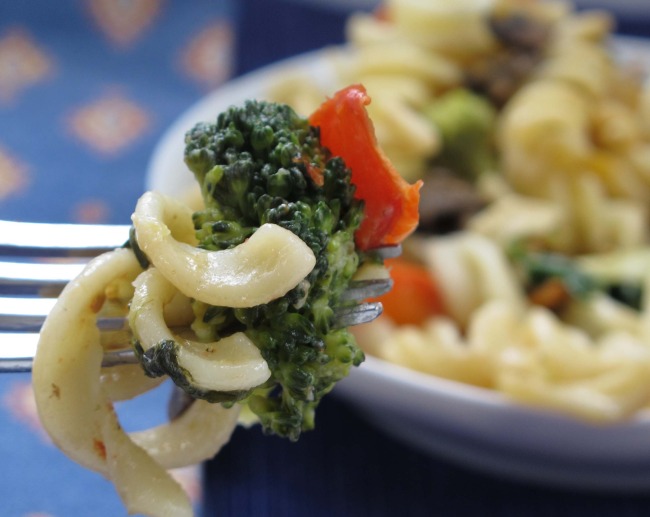Do you ever get home at night, famished, and wonder how quickly you can get food on the table before everyone starts gorging on crackers or worse? If "think fast, cook faster" is your motto, then pasta primavera is your friend.
Of course, I don't mean to suggest that you should only make this when you're in a hurry. Or that it is unworthy of those who have dinner planned every night, with ingredients pre-made (or at least pre-cut) and neatly arrayed in containers, ready to be put together in a flash. But pasta primavera has a special place in my heart because it is a quick, healthy, one-dish meal that never gets tiresome.

My version is not so much a recipe as a set of tips. This "recipe" requires only a bag or box of pasta, random fresh vegetables, a few tablespoons of olive oil, salt and pepper, and a few tablespoons of soft goat cheese. If you've got a container of goat cheese, sun-dried tomatoes and basil appetizer lurking in the freezer, so much the better, but plain goat cheese works fine too. (The appetizer freezes really well; I try to keep small containers frozen -- labeled and dated of course -- to pull out for just this type of occasion.)
The true secret to this version is to use fresh and colorful vegetables. Occasionally I add a few frozen peas, but the vast majority of the vegetables should be fresh. That doesn't mean that you have to buy them especially for this dish. If you keep salad veggies around, then you have great ingredients at hand: carrots; broccoli; green, red, and/or yellow peppers; spinach; and even celery. Add an onion, that zucchini or yellow squash you meant to use earlier in the week, and a few olives and you're set. The number and type of vegetables depend on my mood and what's at hand. The only constant is that I aim for color and variety.
No measurements here -- this is about improvising and ratios. As Michael Ruhlman points out in his cookbook Ratio, the key to much cooking is knowing how to combine ingredients to get the result you seek. I simply gather available vegetables and figure out how much pasta to use to make the dish well-balanced.
My basic pasta primavera formula is three steps, two of which are simultaneous: (1) cook pasta; (2) sauté vegetables (cooking them quickly in a pan, using a small amount of oil); and (3) when they are both done, combine them, add a dollop of goat cheese, mix and add a bit of reserved pasta water, salt and pepper. Stir again. Vegans can easily adapt this recipe by skipping the goat cheese.
Boiling the water for pasta starts immediately; when you begin cooking vegetables depends on which vegetables you'll use. If the pasta gets done before you finish the vegetables, drain it, add a drop of olive oil, and return to the pot until you're ready to add it to the vegetables.
For 5 Tips for Great Pasta Primavera, click here